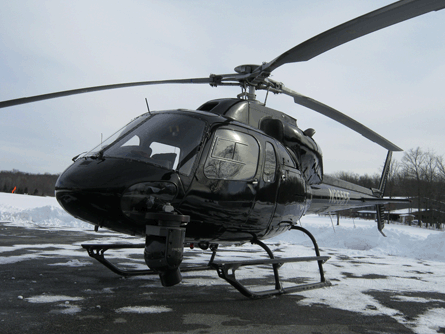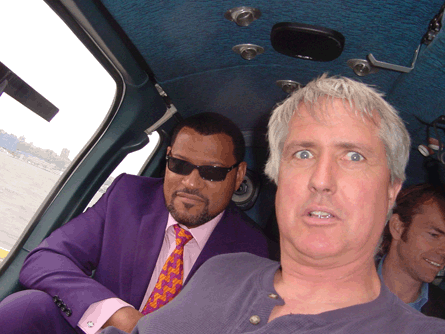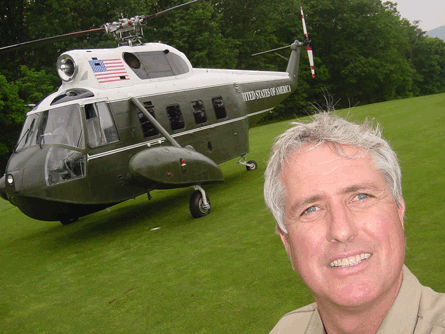Bill Richards has a problem. It should be a routine day for his New York-based company, NY Film Flyers, and his twin-engined Eurocopter AS355 Squirrel.
A Discovery Channel film crew member is on the phone to Richards' office in Gardiner, New York on a frigid, blustery Friday in January, trying to schedule a shoot for a documentary on the lake-effect snow that pummels the communities around the US Great Lakes each winter.
However, some lake-effect snow is threatening the film site. Richards is caught between the demanding schedule of a TV production crew and the risk of ice on the rotors.
Grounded by weather that is the subject as well as the obstacle for today's flight, Richards has a moment to recount the story of a one-man business venture built on an extraordinary career in aviation and film.
 |
|---|
© Alaina MabasoBill Richard's AS355 has a remote-mounted Cineflex V14 high-definition camera riding on its nose |
Richards can often be found flying his Squirrel over New York City, providing the aerial shots needed for the biggest names in the business: "J J Abrams, Steven Spielberg You know those guys." Yes, most of us know of them - but Richards can boast a slightly closer relationship.
There may be plenty of US pilots who are, like Richards, as at home in fixed-wing aircraft as they are in helicopters but, according to Richards, he is the only person in the USA who is a professional film-maker as well as a pilot.
He is certainly one of very few pilots who can provide aircraft as well as invaluable expertise to film-makers from an East Coast headquarters - 90% of US film industry pilots are based in Los Angeles.
Richards estimates there are no more than 20 helicopters in the USA regularly used in the film industry, and their equipment and capabilities vary.
Film is captured from a helicopter in three main ways: a hand-held camera; a larger, side-mounted camera, which Richards compares to a gunner's apparatus (operated directly by a cameraman looking out the side of the aircraft); and a remote-mounted camera on the front of the aircraft.
With the explosion of movie epics in IMAX, some film industry helicopters have had to add extra weight. Helicopters rigged with all the paraphernalia of high-definition IMAX film carry up to 318kg (700lb) in camera equipment and rigging.
Single-engined helicopters, with a comparatively lighter single fuel tank and powerful engine, are best when it comes to handling the IMAX load, Richards says.
His AS355 has a remote-mounted Cineflex V14 high-definition camera riding on its nose. With only the lens and an "acquisition chip" outside the aircraft and the rest of the camera inside, "it is like taking your eyeball out of your head" and still looking through it, he says.
Certainly the Cineflex V14 does resemble a large, beady eye at the helicopter's prow, but this is only part of the camera's capability. Laser gyros - the same technology used in weapon-guidance systems - stabilise the camera so that even while flying at up to 121kt (224km/h), a 360mm lens keeps "absolutely still": not a single vibration rocks the picture. The cost of all that technology? A cool $560,000 - for a single camera.
 |
|---|
© Bill RichardsBill Richaards has worked with numerous Hollywood stars including Clint Eastwood (pictured) |
Now in his fifties, Richards was raised one of 10 siblings in the south-eastern tip of New York state. As a child, he enjoyed day trips to a local airport and as he revelled in the thundering of an aircraft over his family's vantage point, Richards had the first of a lifelong career in aerial thrills.
By the time one of his brothers had qualified for his pilot's licence at 16 - he went on to become a commercial commuter aircraft pilot - aviation had taken hold in the family. As teenagers, Richards and his brother teamed up to buy their first aircraft, a four-passenger Cessna 172.
Richards earned his own fixed-wing pilot's licence the following year. He "caught the bug" for freefall when he took his first skydive at 17 (now joking that in a family of 10 children, a few could be "expendable").
However, a fascination with film predated even his enthusiasm for the air. He remembers shooting film from the time he was 13 and enrolled at New York University's film school, where he was able to bring his two passions together by making a film on skydiving, free-falling with camera in hand.
Having purchased the private Gardiner airport with a few friends in 1979, Richards launched a business in recreational and professional skydiving that thrives to this day.
In any given year, his pair of 22-seat de Havilland DHC-6 Twin Otters host 10,000 first-time jumpers and up to 60,000 experienced jumpers. These days, Richards himself boasts an estimated 12,000 skydives.
While his passion for flight and skydiving continued apace, Richards fashioned a film career, producing software and theatrical staging for corporate events and creating industrial videos However, he never lost his interest in filming from the air.
The first camera Richards attached to an aircraft was a Second World War-era design for aircraft, to help pilots account for spent ammunition.
The first inkling of how successfully Richards could combine film-making and aviation came in 1993. An aerial co-ordinator working with director John Badham (of Saturday Night Fever fame) called Richards to see if he could supply an aircraft to aid shooting on Drop Zone, starring Wesley Snipes.
The film included a scene where hijackers blew the door off a Boeing 747 and parachuted out. During filming over the next year, Richards flew the Twin Otters bearing cameras and rode in film-site helicopters - and caught another "bug".
By Richards' own admission, before Drop Zone he had little interest in flying helicopters. "It just seemed kind of spooky, all that stuff going around," he says of the rotors.
However, the reliability and extraordinary engineering of the helicopter won him over, including the function of the giant propeller-like blades as wings, and the slender yet deceptively strong mast. He earned his helicopter licence and bought his first helicopter, a Bell 206 JetRanger, that same year.
No more filming corporate industrials, Richards launched NY Film Flyers and his office, about an hour's drive from New York City, belies the whirlwind life of a man who has participated in the aerial filming of almost any movie or TV show you would care to name during the past 15 years.
Richards can see his skydiving Twin Otters from the window of a wood-panelled home office lined with cardboard filing boxes, worn green carpeting and faded photos wedged into the ceiling tiles. The clock over the doorway has stopped and notes stick to the computer. He grabs a dusty photo from the window-pane to display the Bell 206 with fatherly pride. It shows a group of kids crowding around the aircraft during a visit to a local school.
Since then, Richards' trips have taken him a little farther afield. He has a hard time deciding which location he likes best.
He has been from Puerto Rico to Japan, from Mt Aconcagua, Argentina, to Monaco, and from Croatia to Tunisia and Morocco (filming Babel, starring Brad Pitt and Cate Blanchett, in the Atlas Mountains).
In his personal photo gallery, arid African dunes give way to astonishing stretches of ice in what may have been his favourite adventure: camping out in the Arctic Circle on a staggering 1,200km (800 miles) expanse of Greenland.
Filming a documentary in Labrador, he flew so far out to sea that, for lack of fuel, he had to land his de-rotored craft on a ferry. While flying over Chile a few years ago, he mistook a volcanic eruption for a forest fire.
 |
|---|
© Bill RichardsRichards has worked with Holywood celebrities including Laurence Fishburne & Hugo Weaving |
Richards' globe-trotting aerial work does not only mean exotic landscapes, he often rubs shoulders - sometimes literally in the confines of the cockpit - with Hollywood's notables.
His personal gallery features directors Robert Luketic and the late Sydney Pollack, producer Ridley Scott, playwright David Mamet and actors Laurence Fishburne, Keanu Reeves and Clint Eastwood - who, as a pilot himself, looks most at home wearing headsets.
A contemplative Sean Penn, during filming of 2005's The Interpreter, was allowed to smoke a cigarette while in Richards' helicopter over New York City.
As he recounts messing about on the set of TV show Survivor with host Jeff Probst or explains how a block of ice, heaved into the river from a helicopter, was digitally replaced by Angelina Jolie in Salt, it is plain that Richards has forged an enviable career. He appreciates that any aerial filming requires teamwork between pilot and cameraman.
He prefers shooting film rather than flying the helicopter but whether filming or piloting, he knows what it takes.
"Trick-flying is not film-flying," he says. Some pilots or audiences might think good aerial visuals mean extravagant stunts but Richards maintains that whether you are on the ground or in the air, filming is all about focus - concentration on the target as well as the scene's composition, movement and light - not fancy moves in the air.
"Aviation automatically puts big production value into a movie," he says. To illustrate, he suggests audiences consider how many movie trailers include aerial shots.
In other words, film-makers can get the most value from a single shot made of a real subject, with no artificial lighting, set pieces or editing required.
Depending on the length of a film, a minute-long aerial piece - such as a title sequence - can mean as much as 1% of the entire film is accomplished in a single shot. It is a boon to a producer's schedule and budget in an industry where most visual sequences require filming and editing of myriad strung-together segments.
The march of computer-generated imagery is changing aerial film-making and the roles of aircraft in movies. Several years ago, Richards notes, a director shooting a scene with multiple aircraft in would have had to actually film those aircraft. Now, CGI can multiply a single filmed aircraft into as many as required.
Richards also notes that aircraft in TV and movies are rarely civil. Most scripts call for military, government or police aircraft. The challenge is that few of these are available, so the rotorcraft to which producers can access undergo a lot of makeovers, emblazoned with the colours and letters of an air force, FBI or whatever the script requires.
 |
|---|
 |
© Bill RichardsRichards notes that aircraft in TV and movies are rarely civil. Most scripts call for military, government or police aircraft. The challenge is that few of these are available, so the rotorcraft to which producers can access undergo a lot of makeovers |
Pilots and cameramen are also essential for "plate shots", usually for what Richards calls "New York City alien-type movies".
A view of a city from the air will be real, Richards assures. It is always cost-effective for a director to film as many real marks as he can rather than generating them digitally.
But a rocket exploding downtown or a monster demolishing buildings? That is added later, of course, on the "plate" of Richards' real shot.
A close look at Richards' work shows some unusual risks. Some helicopter pilots might prefer single-engined aircraft, but not Richards. Some would say a double engine - two hydraulic systems, two electrical systems - means twice as many chances for a failure. However, identifying himself primarily as a fixed-wing pilot, Richards insists two motors are best, particularly because his line of work can mean unusual flight patterns.
"When I'm flying low and slow and hovering in weird places, I just like the peace of mind," he says.
In the case of a failure, would the helicopter fly the same on its remaining engine as it would have on two?
"No, but it'll fly." And that is the key, not just to getting the shot but to getting home safely.
As for the lake-effect snow, it is not uncommon for Richards' flights to take him into terrain and weather other pilots would not attempt.
With a wary eye on the hour-to-hour forecast, the film crew decides to go ahead and Richards lifts off from the pavement outside his home office.
Filming today's documentary about winter weather patterns, he will be deliberately going after the conditions that ground most helicopters and then, due to the production's late-day scheduling, he will add 30min to his nighttime return flight to avoid treacherous winter conditions over the mountains.
However, from airborne actors to documenting the weather, it is all in a day's work for a film flyer.
Source: Flight International



















